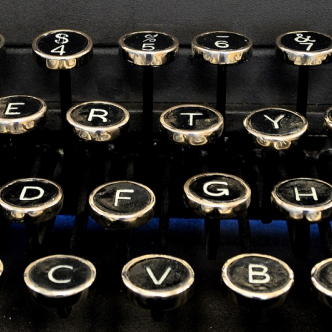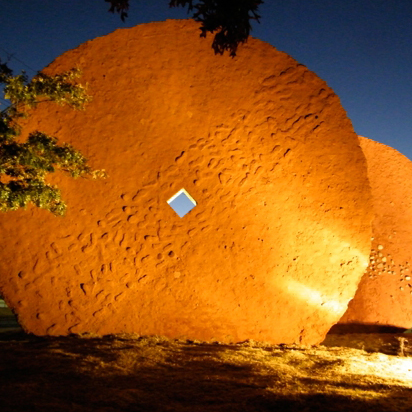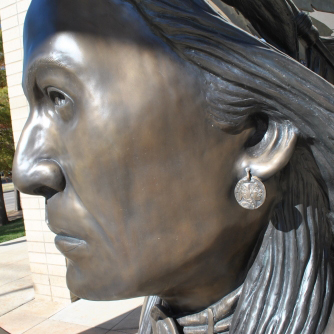Previous Newsletters
|
||||
|
COLLECTIVE MEMORIES
Like most New Yorkers we live in one place and our stuff lives somewhere else. When the seasons change, we make a pilgrimage to our storage unit so that we can dutifully admire and rearrange our possessions. We wade through our exhaustive collection of memorabilia and contemplate downsizing. The clutter is extraordinary. Stacks of notebooks burst with slidefiles documenting countless pilgrimages to important works of architecture. Floppy discs are everywhere, each one backing up something deemed indispensible at the time. What passes for a walkway is lined with piles of audio and videotapes that recorded long-forgotten programs. We contemplate booting up the computer running the single digit operating systems on its 10 megabites of memory the one with the disc drive so that we could deaccession appropriately but know that we'll never untangle the correct cords from our historical stockpile of electrical components, each and every device considered the state of the art the day we bought it. Between Yom Kippur and September 11th this is a difficult time of year. It's our annual reminder about the fragility of modern life. After Sandy we were heartened that we could be of service when it turned out our digital gallery had morphed into one of the most complete collections of New York City's cultural assets. We were surprised when FEMA and the other agencies reached out to us and happy to contribute what we could. This summer we began collaborating with Oklahoma City . They are unfortunately our sister city in tragedy by surviving the twin perils of terrorism and natural disaster. Post 9/11 we were taken aback by disaster tourism and participated in many of the municipal initiatives to reach beyond the 16 acres; Oklahoma Cityis doing exactly the same thing. In the same spirit of design for resilience, our monthly architect Barton Phelps has really addressed how you take aging and much loved buildings and upgrade them to withstand earthquakes, without destroying the qualities that people actually love. Our monthly artists are grappling with working in the ephemeral media: lighting and words John Powell and the partnership of Joe O'Connell and Blessing Hancock. We are realizing that it's one thing to create a website and smartphone app that promotes cultural tourism. It's a far greater responsibility to become the virtual closet for our nation's cultural assets. We need to make sure that the extraordinary content we've been entrusted with doesn't end up in that storage unit in the sky. Abby Suckle, President |
||||
|
FEATURED ART COLLECTION: CITY OF OKLAHOMA CITY PUBLIC ART COLLECTION Even though Oklahoma City has commissioned public art since 1980, much has happened in the last few years. In 2009, the City adopted a percent-for-art program. A Cultural Plan has been written. An Arts District has been created. Work is underway on a public art plan to go with it. And, Project 180 has been launched as an initiative to transform the 180 acres of Downtown 180 degrees into a more pedestrian friendly city. One of its features is the Destination Markers The markers are actually bronze discs planted in the sidewalks at culturally significant places around downtown. Each one depicts an aerial map with a small silver 'you are here' dot. To go with it, there is signage and a brochure. We've been working with the city to make the content more accessible via the iPhone. Skydance Bridge completed last year is a pedestrian bridge spanning I-40 resulting from a national competition to create an iconic symbol for the city. The winning design by Artist Stan Carroll along with Butzner Gardner Architects created a 380' long sculpture that was inspired by the Scissor Tailed Flycatcher, the Oklahoma state bird. |
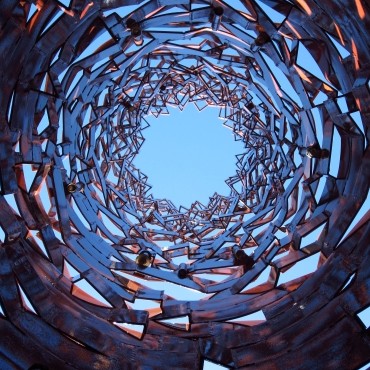 Where the Earth Meets the Sky (2012) Phillip K Smith III
Oklahoma City, OK, Photo © Oklahoma City Arts Commission |
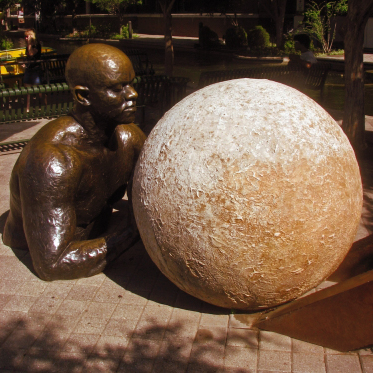 Inclined (2000) David Phelps Oklahoma City, OK, Photo © Oklahoma City Arts Commission |
||
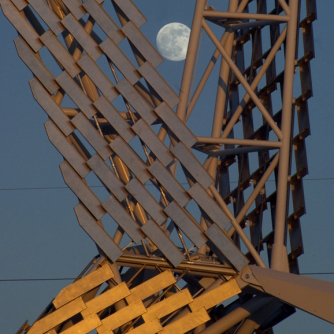 Skydance Bridge (2012) Oklahoma City, OK, Stan Carroll |
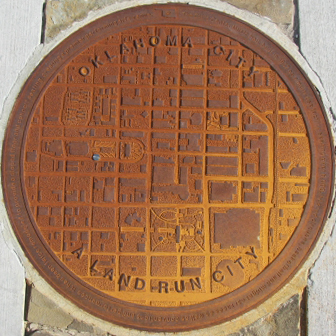 Destination Marker #5 - Civic Center (2011) Oklahoma City, OK Photo © Project 180 |
|||
|
|
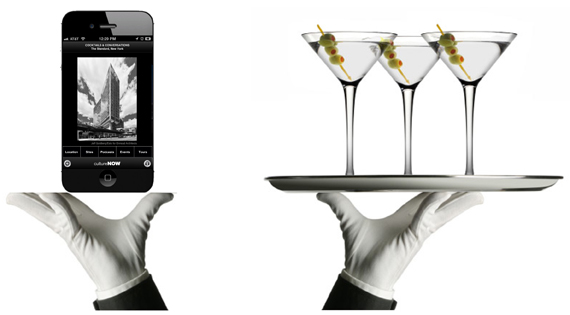
COCKTAILS & CONVERSATIONS: If you're looking for an interesting |
Invisible Royalty Oklahoma City, OK (2012) David Phelps Photo © Courtesy of Oklahoma Art in Public Places |
Disk (2010)Thomas H. Sayre,
Oklahoma City, OK Photo © Kolbe Roper |
|
|
We have the pleasure to welcome a new bartender, Eben Klemm. He is Director of Cocktail Development for B.R. Guest Restaurants/James Hotels. Before moving into the world of cocktail making, Eben was a Molecular Biologist at MIT. We've been assured that this training has influenced his innovative combinations and techniques and will expand the beverage horizons, 'playing not just with flavor but also with form and perception. Bars, after all, are a lot like science laboratories: a flat washable surface, lots of ice, running water and alcohol'. It's obviously not the same, but we do post the recipes online. |
Circle of Life (2009) Oklahoma City, OK, Enoch Kelly Haney Photo © Courtesy of Oklahoma Art in Public Places |
Einstein (2011) Gary Lee Price, Oklahoma City, OK
Photo © Courtesy of Oklahoma Art in Public Places
|
WALKING TOUR: JEWISH ARRIVAL DAY Tour Guide: James Kaplan Sponsor: Temple of Universal Judaism Time: 1:30 - 4:00 PM Date: Sunday September 29th Next Sunday James Kaplan will be leading a walking tour on the history of the Jewish people in America in celebration of Arrival Day, the day in 1654 when the first group of 23 Jews arrived in New York harbor. The tour starts at the flagpole in Peter Minuit Park and then moves through Lower Manhattan ending at the first Shearith Israel cemetary in Chinatown.
| |
|
| ||||
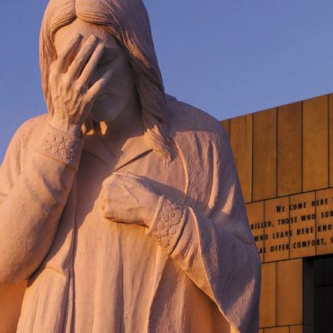 And Jesus Wept (2008) MA+ Architecture, LLC,
Oklahoma City, OK Photo © Oklahoma City Arts Commission |
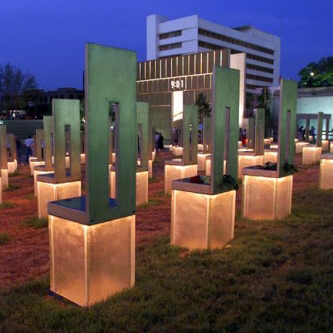 Oklahoma City National Memorial (2000) Oklahoma City, OK
Butzer Gardner Architects with Sven Berg,Photo © Oklahoma City Arts Commission |
|||
|
CHESAPEAKE BOATHOUSE 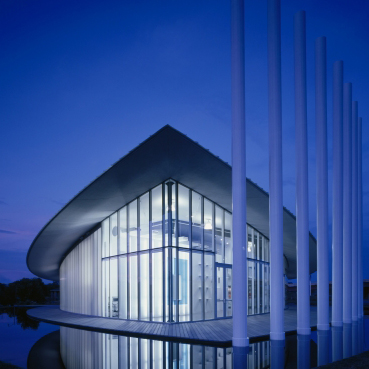
photo © Robert Shimer,
Architect:Hedrich Blessing Elliott + Associates Architects This is the first completed building (2006) on the newly revitalized riverfront. GOLD DOME 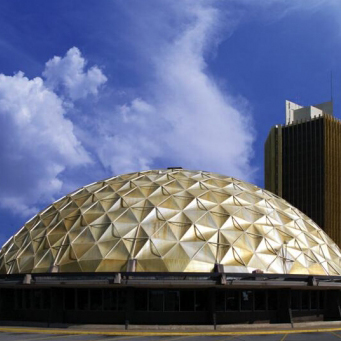 Original Architect (1956):
Original Architect (1956):Bailey Bozalis Dickinson Roloff Renovation Architect (2005): Mike Kertok The 5th geodesic dome to be built in the world, this office building now houses many of the city's cultural organizations. COLCORD BUILDING 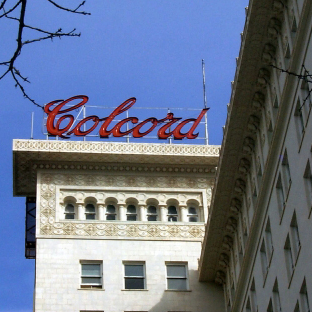 Original Architect (1905): William Wells Renovation Architect (2006): Coury Properties This is Oklahoma's first steel reinforced concrete building, 13 stories tall with a terra cotta frieze by Louis Sullivan. MYRIAD BOTANICAL GARDENS 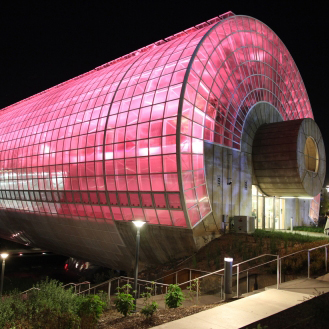
Crystal Bridge Tropical Conservatory
RECENTLY ADDED 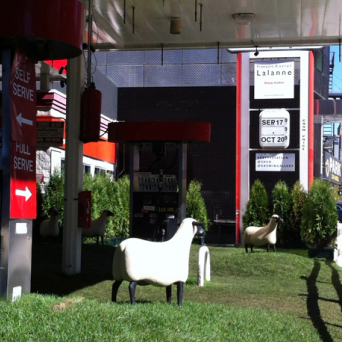
photo © cultureNOW
Getty Station: Even though it seems like there are lots of cars in the city, you could probably count the number of gas stations on the fingers of one hand. To us they are as oases to the Bedouins. Comparison shopping for gasoline may be a worthy pasttime beyond city limits. Here we are so relieved to find any pumps dispensing this precious liquid we happily whip out our American Express cards whatever it costs. Consequently, the loss of a single station is mourned seriously. When our neighborhood Getty Station on the next block shuttered its doors last month, it was considered tragic. Part of the reason that we are city dwellers is because we actually do not know how to live in nature. Rooftops here and there may have been repurposed into urban farms and we all have CSA (Community Supported Agriculture) shares. But in truth we have tenuous ties to the land itself. The other day two wonderful things happened. In the morning trucks delivered hills, sod and potted trees to the site of our former Getty Station, proceeded to build a white picket fence and placed 28 plastic sheep. By nightfall several hundred people were toasting our new farm. Here was our kind of nature. A farm built in a day with a security guard to protect it. It's our Green Acre! INTERESTING FIND 
|
||||
|
FEATURED ARTISTS: JOE O'CONNELL & BLESSING HANCOCK What we like about Joe O'Connell & Blessing Hancock is that their artwork grapples with some of the biggest challenges that face public artists. Commissioned artwork is often small because there isn't money to pay for something larger. It is very difficult to take little objects no matter how interesting they are, knit them intelligently into a larger setting and still make a statement. Finding a way to engage the community is supposed to be part of the process. Artwork in the real world is actually seen around the clock; so the sculptures need to work 24/7. Wondrous , for instance which is placed outside the Wheeler Taft Library is a bent steel wall that is made up of about 1000 English, Spanish and even Indian words taken from books in the library's collection that the neighbors helped select. At night, the words project everywhere creating the effective sign and portal to the building. Bike Church is an open-air structure fabricated out of recycled bike parts welded together with a few stained glass windows and symbols of all faiths. Usually memorials to dead cyclists take the form of ghost bikes. This is a more intriguing way of both acknowledging them and celebrating their lives. |
||||
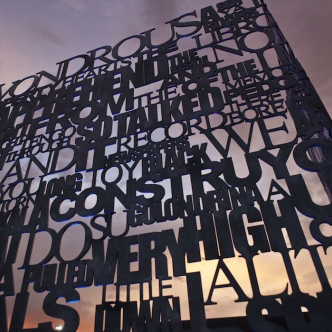
Wondrous (2008) Photo © Joe O'Connell & Blessing Hancock |
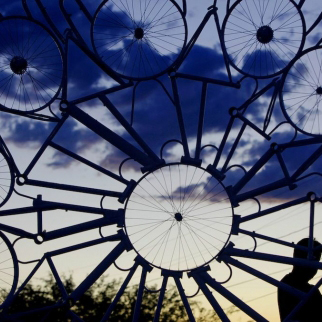
Bike Church (2009) Photo © Joe O'Connell & Blessing Hancock
Tucson, AZ, Pima County Public Art Collection, |
|||
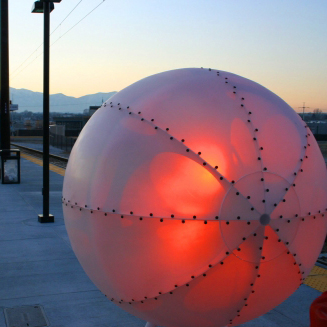 Utah Bit & Mine (2010) Midvale, UT, Utah Transit Authority
|

Toby (2009) Photo ©Joe O'Connell & Blessing Hancock |
|||
|
|
||||
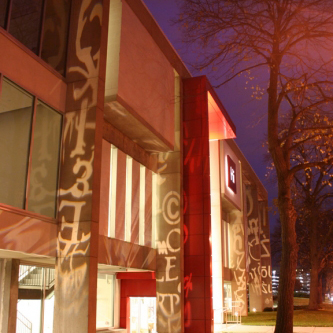
Harvard Innovation Lab - Projections (2011) Allston, MA
Harvard University, Photo © John Powell |
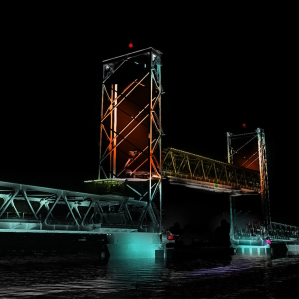
Memorial Bridge (2013) Portsmouth, NH
Photo © John Powell |
|||
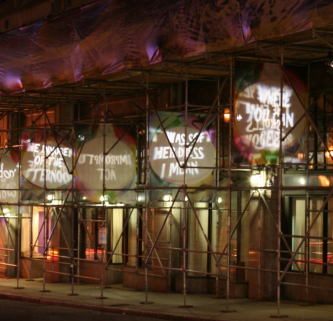
Text Walk (2012) Boston, MA
Photo © John Powell |
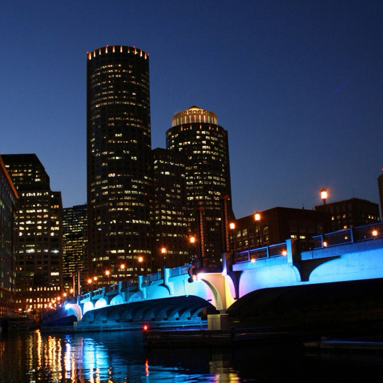
Evelyn Moakley Bridge Lighting (2004)
Boston, MA Boston Art Commission Photo © John Powell |
|||
|
FEATURED ARCHITECT: BARTON PHELPS & ASSOCIATES In 1994 LA was hit with the Northridge earthquake. We were working on the UCLA Business School which survived. For weeks there were aftershocks which felt a lot people pulling the emergency brake on a subway train. The building next door to ours was Royce Hall. This is the building that traditionally has defined the UCLA Campus. No matter how iconic the building, the concept of seismic retrofitting is extremely unglamorous. It is a surgical process, which involves unpeeling the structure, inserting a bunch of steel rods into it and then pinning everything back together in a way that accommodates the extreme horizontal movements. It is quite an expensive process. Firms that specialize in this type of work rarely occupy the more enlightened and visionary end of the profession. We wanted to highlight Barton Phelps because he does represent a more thoughtful approach to design. And, he's done more than anyone to seismically retrofit the buildings at UCLA in a way that accomplishes what needs to be done while still upgrading and updating the campus functionally. He's redefined the process of how to do this kind of work. And how to do it well. This translates into careful siting of new and renovated buildings, such as the work he's done for the Thatcher School campus in Ojai. |
||||
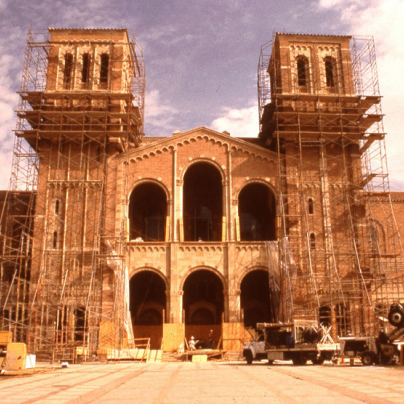
Royce Hall Seismic Upgrades (1998) Los Angeles, CA
Barton Phelps & Associates, Photo © Tom Bonner |
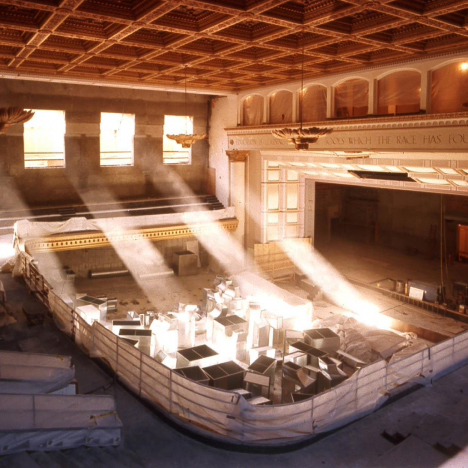
Royce Hall Seismic Upgrades (1998) Los Angeles, CA
Barton Phelps & Associates, Photo © Tom Bonner |
|||
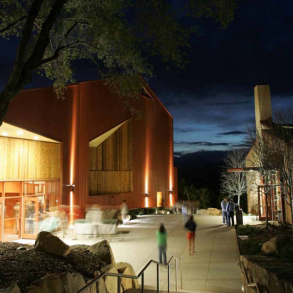
Milligan Arts Building, The Thatcher School (2006) Ojai, CA
Barton Phelps & Associates Photo © Benny Chan, Fotoworks |
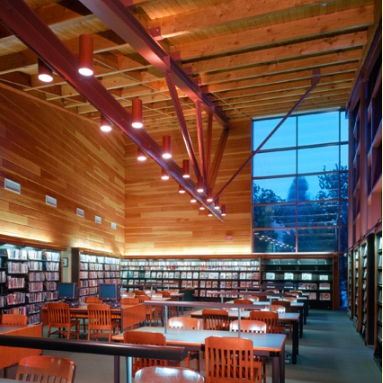
LA Public Library, Woodland Hills Branch Los Angeles, CA
Barton Phelps (2003) Photo © Benny Chan, Fotoworks |
|||
|
||||


